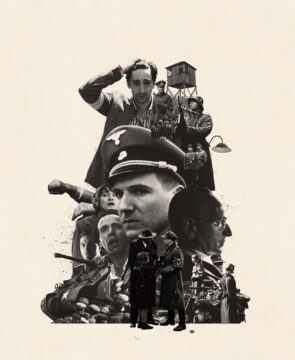Giles Harvey in the New York Times Magazine:
 The British philosopher Gillian Rose, who advised the Polish government on how to redesign the Auschwitz-Birkenau State Museum after the fall of Communism, believed that the new regime of memory was mired in bad faith. By framing the Holocaust as an unfathomable evil — “the ultimate event, the ultimate mystery, never to be comprehended or transmitted,” as the writer Elie Wiesel once put it — we were protecting ourselves, Rose argued, from knowledge of our own capacity for barbarism. “Schindler’s List” was a case in point. For her, Spielberg’s black-and-white epic, which sentimentalizes the Jewish victims and keeps the Nazi perpetrators at arm’s length, was really just a piece of misty-eyed evasion.
The British philosopher Gillian Rose, who advised the Polish government on how to redesign the Auschwitz-Birkenau State Museum after the fall of Communism, believed that the new regime of memory was mired in bad faith. By framing the Holocaust as an unfathomable evil — “the ultimate event, the ultimate mystery, never to be comprehended or transmitted,” as the writer Elie Wiesel once put it — we were protecting ourselves, Rose argued, from knowledge of our own capacity for barbarism. “Schindler’s List” was a case in point. For her, Spielberg’s black-and-white epic, which sentimentalizes the Jewish victims and keeps the Nazi perpetrators at arm’s length, was really just a piece of misty-eyed evasion.
A richer work, she suggested, would present the Holocaust as something legibly human and goad the viewer into asking an uncomfortable question: Could I have participated in this? In a startling passage from her final book, “Mourning Becomes the Law” (1996), Rose called for a film that would center on “the life story of a member of the SS in all its pathos, so that we empathize with him, identify with his hopes and fears, disappointments and rage, so that when it comes to killing, we put our hands on the trigger with him.” Instead of eliciting “sentimental tears,” like Spielberg’s production, such a film would leave us “with the dry eyes of a deep grief.”
“The Zone of Interest,” the astonishing new film from Jonathan Glazer, one of England’s most talented and unpredictable directors, can feel at times as if it were made to fulfill Rose’s desideratum.
More here.
 The quantum computer revolution may be further off and more limited than many have been led to believe. That’s the message coming from a small but vocal set of prominent skeptics in and around the emerging quantum computing industry.
The quantum computer revolution may be further off and more limited than many have been led to believe. That’s the message coming from a small but vocal set of prominent skeptics in and around the emerging quantum computing industry.
 Meredith Lue, president of the Mary Ellen Mark Foundation told CNN via video call that the photographer, who experienced a challenging family life in her youth, found herself gravitating toward — and connecting with — people in vulnerable situations.
Meredith Lue, president of the Mary Ellen Mark Foundation told CNN via video call that the photographer, who experienced a challenging family life in her youth, found herself gravitating toward — and connecting with — people in vulnerable situations. “Palestine is a story away.” This is what Refaat Alareer wrote on my copy of the short story anthology he edited in 2014, Gaza Writes Back. The contributors were his students at the Islamic University of Gaza.
“Palestine is a story away.” This is what Refaat Alareer wrote on my copy of the short story anthology he edited in 2014, Gaza Writes Back. The contributors were his students at the Islamic University of Gaza. Every year at this time, people making resolutions look to self-help books to guide them in their new goals and ambitions. But our self-help is over-simplified easy optimism, a hangover from the days when How to Win Friends and Influence People defined the genre. It’s a mass of stoicism, wellbeing, minimalism, misunderstood Taoism, and productivity and habit advice. This sort of self-help can often be useful, but it is not a whole way of living. Rules for life and aphorisms are a starting point. The Ten Commandments are the original ten rules for life, but they came with the Bible, one of the largest, most challenging books ever written. The more accessible self-help becomes, the less useful it really is.
Every year at this time, people making resolutions look to self-help books to guide them in their new goals and ambitions. But our self-help is over-simplified easy optimism, a hangover from the days when How to Win Friends and Influence People defined the genre. It’s a mass of stoicism, wellbeing, minimalism, misunderstood Taoism, and productivity and habit advice. This sort of self-help can often be useful, but it is not a whole way of living. Rules for life and aphorisms are a starting point. The Ten Commandments are the original ten rules for life, but they came with the Bible, one of the largest, most challenging books ever written. The more accessible self-help becomes, the less useful it really is. In September, scientists at the Guangzhou Institutes of Biomedicine and Health
In September, scientists at the Guangzhou Institutes of Biomedicine and Health  Margaret Cavendish
Margaret Cavendish A
A MOST AMERICAN SCHOOLCHILDREN
MOST AMERICAN SCHOOLCHILDREN T
T
 The British philosopher Gillian Rose, who advised the Polish government on how to redesign the Auschwitz-Birkenau State Museum after the fall of Communism, believed that the new regime of memory was mired in bad faith. By framing the Holocaust as an unfathomable evil — “the ultimate event, the ultimate mystery, never to be comprehended or transmitted,” as the writer Elie Wiesel once put it — we were protecting ourselves, Rose argued, from knowledge of our own capacity for barbarism. “Schindler’s List” was a case in point. For her, Spielberg’s black-and-white epic, which sentimentalizes the Jewish victims and keeps the Nazi perpetrators at arm’s length, was really just a piece of misty-eyed evasion.
The British philosopher Gillian Rose, who advised the Polish government on how to redesign the Auschwitz-Birkenau State Museum after the fall of Communism, believed that the new regime of memory was mired in bad faith. By framing the Holocaust as an unfathomable evil — “the ultimate event, the ultimate mystery, never to be comprehended or transmitted,” as the writer Elie Wiesel once put it — we were protecting ourselves, Rose argued, from knowledge of our own capacity for barbarism. “Schindler’s List” was a case in point. For her, Spielberg’s black-and-white epic, which sentimentalizes the Jewish victims and keeps the Nazi perpetrators at arm’s length, was really just a piece of misty-eyed evasion.